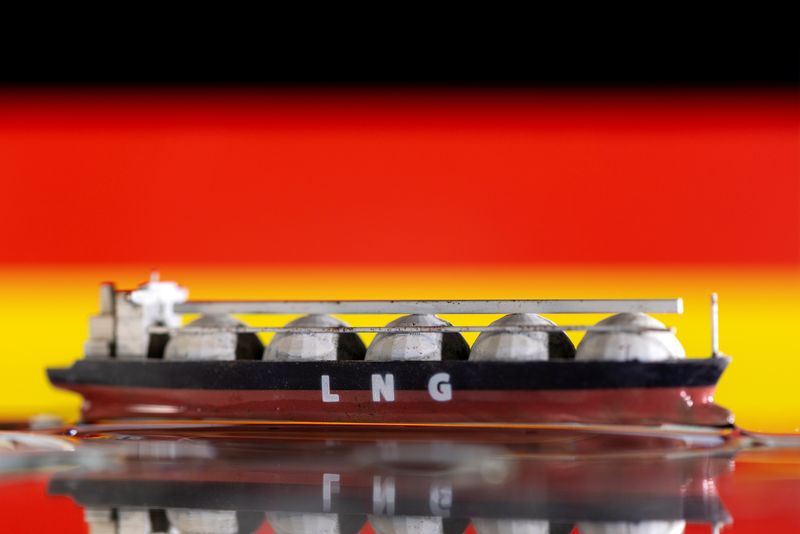(Reuters) - Private company Deutsche ReGas on April 3 ended a gas shuttle service from storage vessel Seapeak Hispania to the Baltic Sea port of Lubmin.
The halt was in preparation for moving the floating storage regasification unit (FSRU) Neptune, moored in Lubmin, to its new Mukran port terminal on nearby Ruegen island.
The Neptune had received its liquefied natural gas (LNG) cargoes first via the Seapak Hispania, another storage vessel, in a shuttle set-up accounting for shallow water.
The company said this is the first step towards moving its LNG operations from Lubmin, where they began early in 2023, entirely to Mukran, and focusing on clean hydrogen activities at Lubmin in future.
The projects are part of Germany's push to widen its gas import options to replace Russian supply.
Last month, a final investment decision was taken to build an LNG terminal by 2027 at the Elbe River inland port of Stade.
Germany has three floating storage regasification units(FSRUs) working at the ports of Wilhelmshaven, Brunsbuettel and Lubmin.
In addition, the Energos Power, arrived on Feb. 24 at Mukran for testing, inland river port Stade received an FSRU last month, and Wilhelmshaven will also receive a second one.
State-owned Deutsche Energy Terminal (DET) in January commissioned Lithuania's Klaipedos Nafta (KN) to manage four locations on the North Sea: Wilhelmshaven 1 and 2, Brunsbuettel and Stade.
Here are details about Germany's LNG sites:
MUKRAN
The Energos Power will be joined by the Neptune in the early summer so that both can deliver gas to the mainland, ReGas said.
Mukran will supply onshore grids via grid firm Gascade's new OAL pipeline. Gascade said on Feb. 26 the 50-km (30-mile) OAL was complete and feed-in was possible.
ReGas holds long-term supply deals with France's TotalEnergies (LON:TTEF) and trading group MET.
The Mukran project has triggered local opposition. Legal challenges by environmental groups DUH and Nabu were thrown out by the federal administrative court.
WILHELMSHAVEN
Utility Uniper launched Germany's first FSRU operations, Wilhelmshaven 1, in December 2022. [LNG/TKUK]
Tree Energy Solutions (TES) plans to operate a second FSRU, Wilhelmshaven 2, between 2024 and 2027.
Further ahead, Uniper plans to add a land-based ammonia reception terminal and cracker in the second half of this decade. Ammonia is at times used as a carrier for hydrogen, whose low density otherwise makes transportation over long distances complicated.
TES plans to eventually convert its operations to clean gases.
LUBMIN
The FSRU Neptune, chartered by Deutsche ReGas and now due to go to Mukran, began receiving LNG at Lubmin in early 2023.
Before being shuttled to Lubmin, the gas was first delivered to the Seapeak Hispania, which is now earmarked to leave the region.
ReGas plans hydrogen electrolysis plants at both Lubmin and Mukran.
Gascade has created a grid connection to the Eugal 1 and 2 gas pipelines for a green hydrogen production project by developer HH2E at Lubmin. it will be able to transport both gas and hydrogen blends.
BRUNSBUETTEL
The Brunsbuettel FSRU went into operation in April 2023, initially chartered and operated by utility RWE (LON:0HA0)'s trading arm before it was handed over to DET at the start of 2024.
It is the forerunner of a land-based LNG facility which has been cleared to receive 40 million euros of state support, that could start operations at the end of 2026, when an adjacent ammonia terminal could also start up.
State bank KfW, Gasunie and RWE are stakeholders and Shell (LON:RDSa) has committed to sizeable purchases.
STADE
The FSRU Energos Force arrived on March 15 where it is expected to operate until 2027 when an onshore terminal is expected to start operations.
A final investment decision to build the terminal was announced on March 21 by project firm Hanseatic Energy Hub (HEH).
The terminal, to be built by Spain's Tecnicas Reunidas, is expected to cost around 1 billion euros ($1.09 billion).
Gas has been allocated to state-controlled SEFE, utility EnBW and Czech utility CEZ.
HEH said the terminal will be equipped to handle LNG, synthetic natural gas and liquefied biomethane.

HEH is backed by investment firm Partners Group, logistics group Buss, chemicals company Dow and Spanish grid operator Enagas.
($1 = 0.9214 euros)